Shallow Wells, Not a Shallow Concern
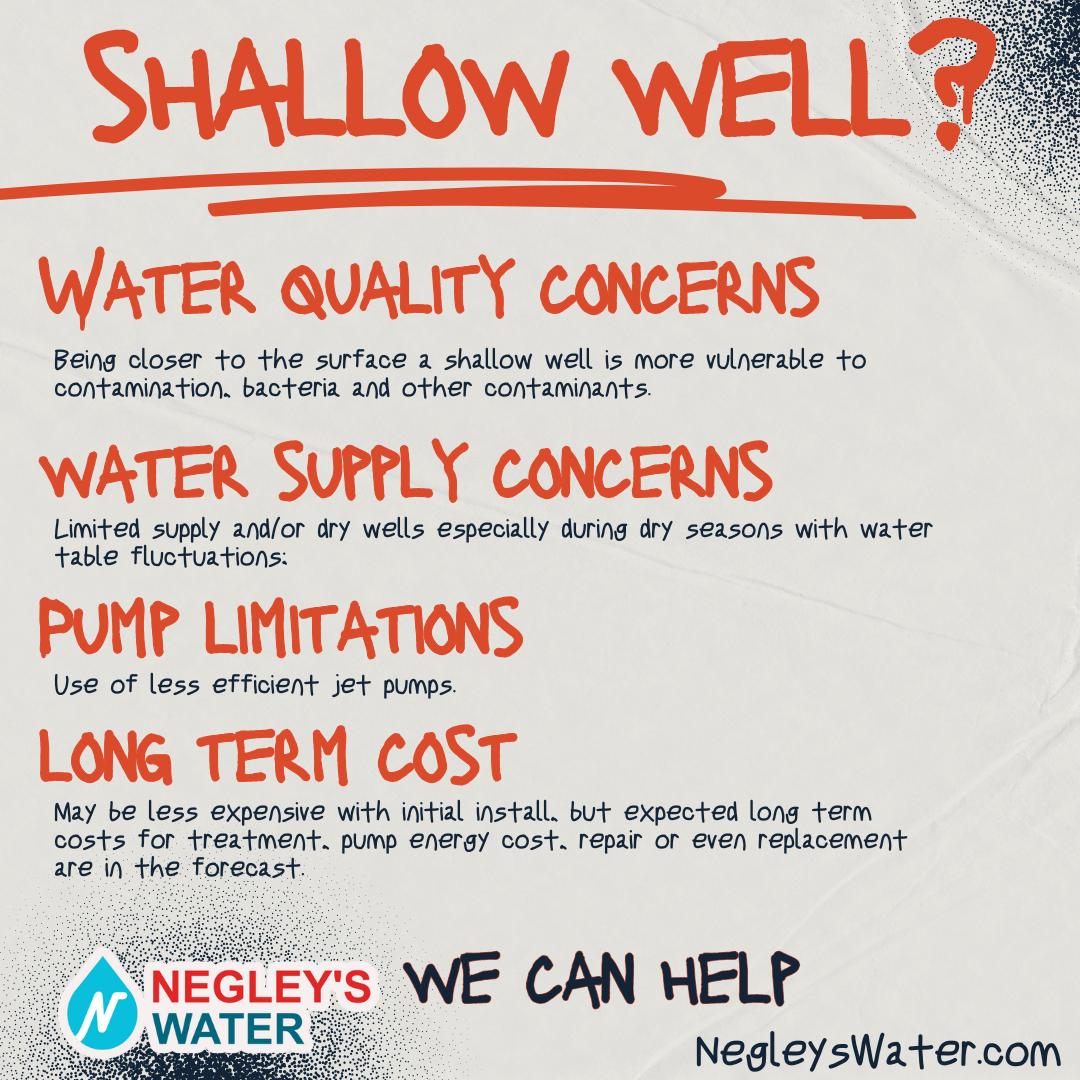
In the instance of a shallow well, that experience only offers a fleeting glimpse of depth.
Loss of time, money and comfort may be in that well’s future. Although shallow wells present an appealing up front low cost, opposed to that of its deeper well counterpart, long term spending may outweigh that instant benefit. A shallow well, also called a dug well, is a well that is less than 50 feet deep and above the bedrock. Like any water well, a shallow well is dependent on geology and water table depth.
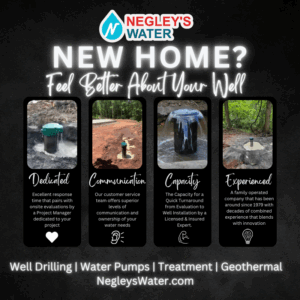
Shallow water wells are installed with access to water sources that are closer to the surface. How close? The depth of a shallow well is dependent on specific geographic location, hydrology and a fluctuating water table. There are two types of shallow water wells. The first one is a dug or bored well and has a range of 10 to 30 feet that can be dug by shovel or backhoe. Dug water wells typically have a large diameter and are lined with stones, brick or tile, but lack continuous casing. The other type of shallow water well is a driven well. A driven well is when the casing or pipe is driven into the ground and in most instances the well will lay 30 to 50 feet deep.
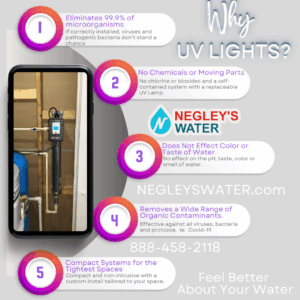
Don’t Let Shallow Thinking Lead to a Dry Future.
“You can’t draw water from an empty well.” A shallow well is often the first to feel the effects of a drought. Shallow water wells are vulnerable to decreasing ground water collection, because wells that are under 50 feet draw from the highest points of the aquifer. As the dry season continues so do the chances of turning the spout and nothing coming out. (or at the very least, losing water pressure.) In areas with low ground water recharge, shallow wells are not a sustainable water source.
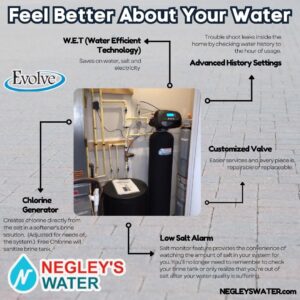
Possible Solutions to a Dry Shallow Well:
- Hydrofracturing (or deepening the well): Deepening the well will provide more storage space for water volume. With the standard 6 inch diameter of a well for every 1 foot in depth will equate to 1.5 gallons of water storage. Also, deepening the well might tap into another more viable aquifer. Well drilling project managers will evaluate native geology and local water table conditions to see if this is the right option. In most cases the circumstances have to be perfect for this method to work.
- Lowering the Pump: This possible solution to a dry shallow well is only going to work if there is water below the pump’s current level. Connecting with a local water pump expert is the first step in evaluating if this is a feasible solution. The lower you go, the more mineral content that could be present when lowering a water pump. Sacrificing water quality to get supply could be one of the effects of lowering a water pump.
- Adding a Storage Tank: By adding a water storage tank to a shallow well the water tank can provide a buffer for low producing wells. This will also reduce the frequency of well pump starts.
- Well Replacement: When the dry shallow well is older than a few decades consideration to drilling a new well should be mulled. The average lifespan of a water well is 20-30 years (but some could reach over 50 years) depending on the water table, conditions and general maintenance. Replacing a well is a considerable investment, but with new technology, materials and methods there are advantages with efficiency and durability. When a new well is dug be sure proper local procedures are taken to decommission the previous well.
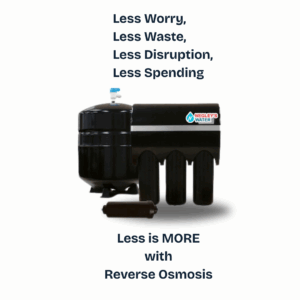
Shallow Well, Deep Worries
With a shallow home well surface activities directly affect the quality of the home’s water. Shallow wells are more susceptible to bacteria, fertilizers and pesticides.
Contamination Concerns:
- Surface Water Concerns: Shallow wells pull their water supply from near the surface. The closer the well is to the surface the more likely it will have variables due to construction/industrial runoff, agricultural runoff, septic systems, and even transportation/infrastructure (oil and salt) runoff.
- Bacterial Concerns: The supply of a shallow water well is typically more stagnant than a deeper water well. Because of that it is more hospitable to bacteria growth. Possible bacteria that could be present within a shallow well include E Coli and cloriform bacteria. The presence of those two types of bacteria might be the introduction to other harmful pathogens.
- Limited Filtration: Water within a shallow well typically doesn’t provide the full filtered experience of a deeper well. It hasn’t been provided the depth or the time to filter through the soil like a deeper water well source. (condition and location specific).
- Well Construction: Dug or bored shallow wells present problems of porous casing that leaves larger gaps for surface water to enter and in some cases small animals to intrude.

Possible Remedies for Contamination Concerns:
- UV light treatment: At Negley’s we recommend a UV light with all well water sources. A UV light is a chemical-free method of water disinfection and sanitation. It uses ultra violet light to inactivate harmful bacteria and viruses. The UV light will penetrate the microorganism’s DNA and disrupt their ability to reproduce or cause illness. A UV light is essentially an “air bag” for your home’s water. Heaven forbid if you’d ever have to use it, but it’s safety insurance for your home’s drinking water.
- Reverse Osmosis: ROs use a 4 stage filtration system that polishes and purifies water sources to a delicious and safe quality. It uses a sediment filter, activated carbon, a semi permeable membrane and then a final carbon polish to remove up to 98.9 percent of all contaminants. (such as nitrates and pesticides). With a shallow well reverse osmosis pairs best with a UV Light and a water softener for the highest level of peace of mind with a home’s water quality.
- Water Test: The first step with any shallow well concern is an evaluation by a local expert. You’re not going to be able to know what to fix if you don’t know what’s wrong. Negley’s Water offers a free analysis and consultation. The process will take an approximate 45 minutes and one of our water consultants will be able to offer further paid laboratory testing, possible solutions or reassurance that your water is at the level of quality your home and family deserve.
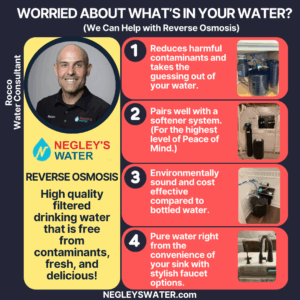
Water Quality Concerns:
- Sediment: Shallow water wells have a closer proximity to surface sediment. The geological formations above the bedrock can be unstable and cause particles to find their way into a home’s water supply. Not only can sediment make water quality cloudy, it can damage plumbing and appliances.

Possible Remediation for Water Quality Concerns
- Water Evaluation: Again, a local water expert needs to be contacted to analyze and evaluate where you’re at and maybe where you need to go. Sediment concerns can be addressed with filtration or in some cases a backwash system. Either way, Negley’s can give your water, your home and of course you- the proper recommendation.

Beneath the Surface
Shallow well, deep concerns? Although the cost convenience presents an interesting first glance, problems that may arise present future risk for your pocket book, quality, supply and even safety. Proactive testing is the first step in understanding your home’s water supply. Don’t wait for problems to arise, have a conversation with one of our local water experts today. Maintaining a safe and efficient well isn’t a problem you have to face alone. Negley’s Water is here to help you Feel Better About Your Water.